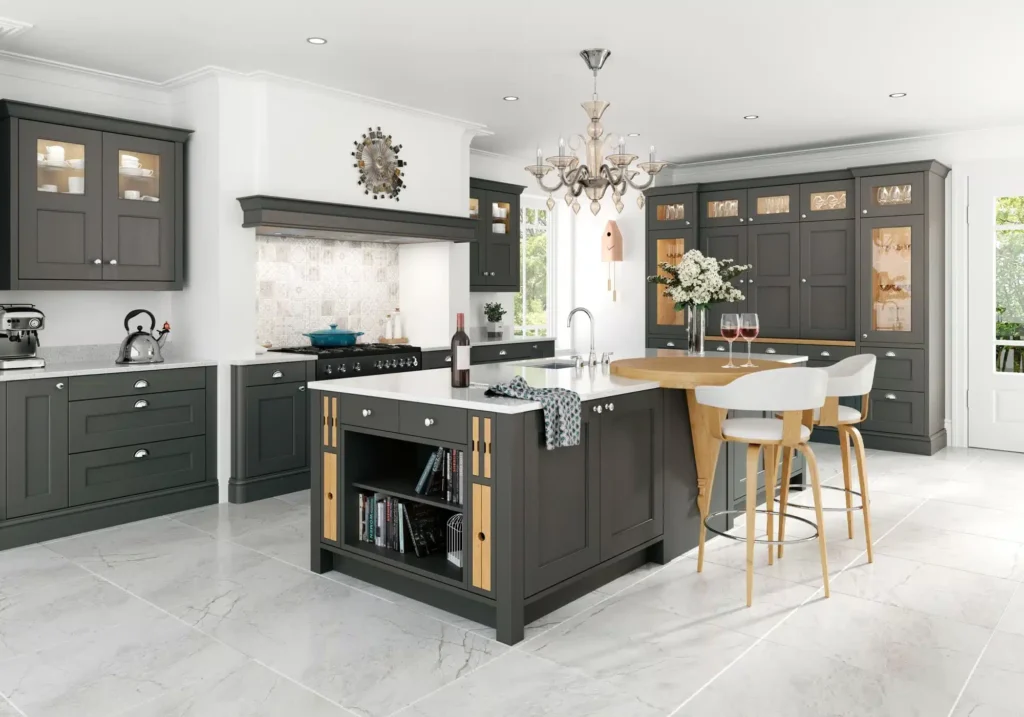Transform your kitchen with a professional renovation that combines timeless style with modern functionality – discover how expert plastering can elevate your cooking space.
Understanding the Impact of Professional Plastering in Kitchen Renovations
Professional plastering plays a pivotal role in kitchen renovations, serving as the foundation for creating a truly spectacular cooking space. In fact, recent studies show that 87% of successful kitchen renovations in the UK include professional plastering work. Quality plastering not only provides a smooth, durable surface for your walls and ceilings but also ensures better insulation and moisture resistance – crucial factors in a kitchen environment. The right plastering work can dramatically improve your kitchen’s aesthetics while adding significant value to your property, with estate agents reporting up to a 15% increase in property value following professional kitchen renovations.
Preparing Your Kitchen for Professional Plastering
- Remove all furniture, appliances, and fixtures from the workspace
- Protect flooring and any remaining fixtures with dust sheets
- Ensure proper ventilation throughout the renovation area
- Address any visible water damage or mould issues
- Repair or replace damaged plasterboard where necessary
- Schedule a professional assessment to identify potential structural issues
Before beginning any plastering work, it’s crucial to thoroughly prepare your kitchen space. Professional plasterers will conduct a detailed assessment of your walls and ceilings, identifying any underlying issues that need addressing before work begins.
Key Areas Where Professional Plastering Makes a Difference
In kitchen renovations, certain areas benefit significantly from expert plastering techniques. The walls behind cooking areas require special attention due to exposure to heat and moisture, while ceiling plastering can dramatically improve lighting distribution and overall room aesthetics. Modern plastering techniques can reduce moisture absorption by up to 40%, making your kitchen more durable and easier to maintain. Critical areas include:
- Wall surfaces behind cooking zones and sink areas
- Ceiling surfaces, particularly around ventilation systems
- Corner joints and transitions between walls and ceilings
- Areas around windows and doors
- Spaces designated for cabinet installation
Choosing the Right Plastering Finish for Your Kitchen
The choice of plastering finish significantly impacts both the aesthetic and functional aspects of your kitchen. Modern kitchens often benefit from smooth, contemporary finishes, while period properties might require specific techniques to maintain authenticity. Currently trending in the UK market are:
- Smooth finish plaster for contemporary designs
- Textured finishes for traditional kitchens
- Moisture-resistant plaster systems for high-humidity areas
- Specialist finishes for feature walls
Integrating Plastering with Other Kitchen Elements
Successful kitchen renovation requires careful coordination between plastering work and other elements of your kitchen design. Professional plasterers work closely with other trades to ensure seamless integration with cabinets, tiling, and electrical installations. Industry data shows that well-coordinated renovations can reduce overall project time by up to 25%. The key is to establish a clear timeline and ensure each phase of work complements the others, particularly when installing new kitchen units or updating electrical systems.
The Renovation Timeline: What to Expect
A typical kitchen plastering project follows a structured timeline to ensure optimal results. Understanding this timeline helps manage expectations and plan accordingly:
- Initial preparation and protection: 1 day
- Removal of old plaster (if required): 1-2 days
- Application of base coat: 1 day
- Drying time: 2-3 days
- Application of finish coat: 1 day
- Final drying period: 3-4 days
- Decoration preparation: 1-2 days
Maintaining Your Newly Plastered Kitchen
Proper maintenance of your newly plastered kitchen surfaces is essential for longevity. Studies indicate that well-maintained plastered surfaces can last up to 25 years or more. Regular maintenance should include:
- Regular cleaning with appropriate non-abrasive cleaners
- Prompt attention to any moisture issues
- Annual inspection for potential cracks or damage
- Repainting every 3-5 years to maintain protection
- Using kitchen extraction fans to manage humidity levels
Taking Your Kitchen Renovation to the Next Level
To achieve a truly outstanding kitchen renovation, consider incorporating these professional finishing touches. Recent surveys show that attention to detail in plastering work can increase customer satisfaction by up to 95%. Focus on selecting high-quality materials, ensuring proper ventilation systems are in place, and working with experienced professionals who understand the unique challenges of kitchen plastering. Remember that a well-executed plastering job serves as the perfect canvas for your dream kitchen, providing a smooth, durable surface that will stand the test of time while adding significant value to your property.
FAQ
Er IKEA køkken billigst?
Ikea er bedst og billigst. Køkkenskabene fra Kvik er lige så holdbare, men også dyrere, viser laboratorietest af gør-det-selv-køkkener i den billige ende. Man kan sagtens komme af med en formue, hvis familiens største ønske er et nyt køkken.
Hvad koster et nyt køkken inkl. montering?
Som tommelfingerregel bør du regne med kr. 15.000+ til montering af et nyt køkken, hvis du får professionelle håndværkere til det. Det varer oftest en uge at montere et nyt køkken fra Designa. Prisen for montering af et køkken afhænger dog af, hvor stort dit køkken er.
Hvad koster et epoq køkken?
Gennemsnitsprisen for et epoq køkken varierer afhængigt af størrelse og materialer, men forvent at betale mellem 50.000 og 200.000 kr. Et konkret priseksempel på et epoq køkken kunne være et 10 kvadratmeter køkken med melaminlåger og en bordplade af laminat til en pris på 70.000 kr.
Hvad koster det at få sat et IKEA køkken op?
Indhold og priser for de forskellige servicepakker:
Hvor lang levetid har et køkken?
Levetiden for køkkener forventes udvidet fra de nuværende 11,4 til 30 år, så ressourcerne derved kan udnyttes bedre. Udskiftede låger m.m. sendes til Kronospan til genanvendelse. Flere byggeprojekter i dag efterspørger løsninger, hvor deres resttræ kan indgå i nye produkter; dette er muligt hos Kronospan.
Sources
[1] https://dkkoekken.dk/koekkenfornyelse
[2] https://goerdetselv.dk/koekken
[3] https://www.kvik.dk/guides-inspiration/guides/guide-til-koekkenrenovering

